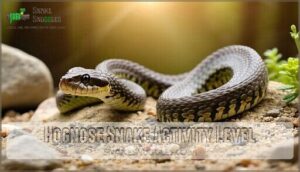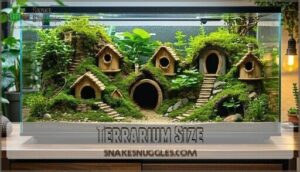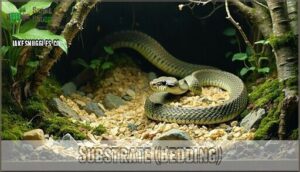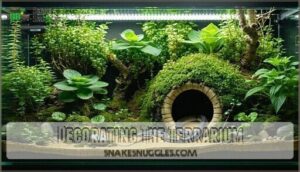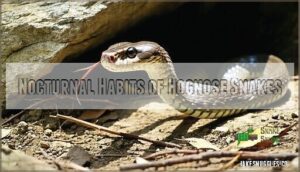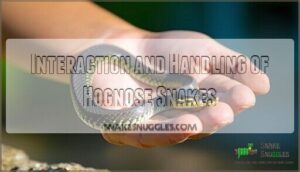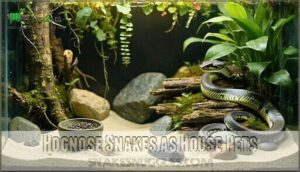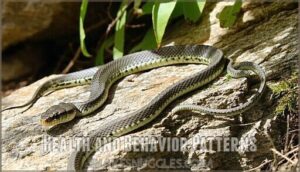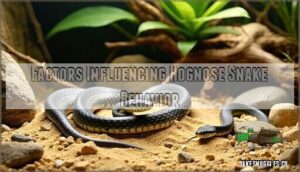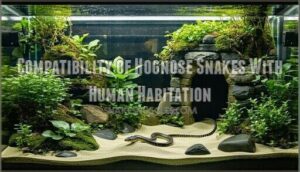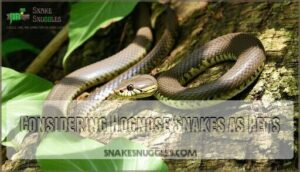This site is supported by our readers. We may earn a commission, at no cost to you, if you purchase through links.
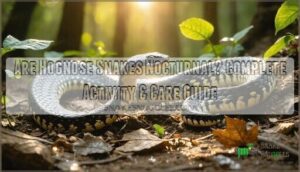
Their round pupils give them away—they’ve evolved for daytime living, not nighttime prowling like slit-pupiled species. These charming reptiles are most active during mornings and late afternoons, typically spending 2-3 hours daily exploring before retreating to their favorite pastime: burrowing underground.
Don’t worry if yours seems "inactive"—they’re natural homebodies who spend most time tunneling through substrate for exercise and temperature control. This underground lifestyle means their fossorial movements often happen out of sight, making proper terrarium setup essential for accommodating their unique behavioral patterns.
Table Of Contents
- Key Takeaways
- Are Hognose Snakes Nocturnal?
- Hognose Snake Activity Level
- Hognose Snake Living Environment
- Nocturnal Habits of Hognose Snakes
- Interaction and Handling of Hognose Snakes
- Hognose Snakes as House Pets
- Notable Characteristics of Hognose Snakes
- Health and Behavior Patterns
- Factors Influencing Hognose Snake Behavior
- Compatibility of Hognose Snakes With Human Habitation
- Considering Hognose Snakes as Pets
- Frequently Asked Questions (FAQs)
- Are hognose snakes very active?
- Are hognose snakes good to have around the house?
- Do hognose snakes like to be handled?
- Can you keep a hognose snake as a pet?
- How often do hognose snakes need to be fed?
- What is the average lifespan of a hognose snake?
- Can hognose snakes climb or escape their enclosures?
- Are hognose snakes legal to own as pets?
- How much do hognose snakes cost to purchase?
- Do hognose snakes brumate in winter?
- Conclusion
Key Takeaways
- You’ve got a daytime pet, not a nighttime one – Hognose snakes are diurnal, meaning they’re most active during morning and late afternoon hours, not at night like many people assume.
- Don’t worry if they seem "lazy" – These snakes only spend 2-3 hours daily exploring before retreating underground to burrow, which is completely normal behavior for their species.
- Their round pupils give away their daytime nature – Unlike truly nocturnal snakes with slit pupils, hognose snakes have round pupils that evolved for daylight vision and activity.
- You’ll need proper substrate depth for their underground lifestyle – Provide at least 4 inches of appropriate bedding since they’re fossorial creatures who spend most of their time tunneling and burrowing beneath the surface.
Are Hognose Snakes Nocturnal?
Contrary to popular belief, hognose snakes aren’t nocturnal animals. These fascinating reptiles exhibit diurnal behavior, meaning they’re most active during daylight hours.
Hognose snakes are daytime performers, not midnight wanderers—surprising most reptile enthusiasts with their bright-eyed, bushy-tailed morning energy
Snake nocturnality is a common nocturnal myth surrounding hognose snake behavior. Their round pupils indicate daytime habits, with peak snake activity occurring during morning and late afternoon periods, directly impacting your hognose care routine.
Understanding their natural behavior is essential, as it relates to crepuscular animal characteristics that can inform their care and activity patterns.
Hognose Snake Activity Level
Diurnal Behavior defines hognose snakes perfectly—they’re most active during daylight hours, particularly mornings and late afternoons.
These Activity Patterns reveal snakes that spend only 2-3 hours daily exploring, with most time dedicated to Burrowing Habits beneath substrate.
Their round pupils confirm this daytime preference, distinguishing them from truly nocturnal animals.
Snake Exercise occurs primarily through fossorial movement—digging and tunneling behaviors that support Thermal Regulation.
Understanding hognose snake behavior helps you recognize that limited visible activity doesn’t indicate illness.
Their snake nocturnality is minimal, making hognose snake habits predictably daytime-oriented rather than following typical animal nocturnality patterns.
To create an ideal environment, this is vital for these unique creatures: follow proper snake care guidelines.
Hognose Snake Living Environment
Creating the perfect habitat for your hognose snake requires attention to several key environmental factors that directly impact their health and behavior.
You’ll need to balance proper terrarium dimensions, lighting cycles, temperature gradients, and humidity levels while selecting appropriate substrates and enrichment items to replicate their natural prairie environment.
Terrarium Size
Most hognose snakes need adequate Tank Dimensions to thrive in captivity. Enclosure Depth matters as much as floor space for these burrowing specialists.
Essential hognose snake habitat requirements:
- Snake Length determines minimum enclosure size – match tank length to your snake’s adult size
- Habitat Space should provide 40+ gallons for adults with proper temperature gradient zones
- Substrate Volume needs 4+ inches depth for natural digging behaviors
- Multiple hide boxes positioned across warm and cool sides for security
Lighting, Temperatures & Humidity
Creating proper lighting, temperatures & humidity transforms your hognose snake habitat into a thriving environment.
Establish thermal gradients with basking temperatures reaching 90-95°F while maintaining ambient conditions of 80-85°F on the warm side.
Temperature control requires reliable heating elements and thermostats for consistent regulation.
Humidity levels should remain between 30-50% to prevent respiratory issues.
Lighting options include basic daylight cycles supporting their diurnal nature, though specialized UV lighting isn’t essential for nocturnal pets.
Proper snake care involves understanding snake health issues to guarantee a long and healthy life for your pet, which is crucial for a happy pet.
Substrate (Bedding)
Your hognose snake needs substrate that supports their natural burrowing instincts.
Aspen shavings work well for beginners, while soil mixes offer superior humidity control and tunnel stability.
Maintain substrate depth of at least four inches – deeper lets your snake create proper burrows.
Avoid cedar or pine bedding options, as these contain harmful oils.
Quality substrate makes nocturnal pets feel secure during rest periods.
Proper snake aspen bedding options are essential for a healthy environment and support the snake’s natural behavior, ensuring they have a suitable place to rest, which is crucial for their overall well-being.
Decorating The Terrarium
Why settle for bare walls when decorative elements transform your terrarium into a thriving ecosystem?
Cork rounds, grape wood, and terrarium plants create natural hiding spots while maintaining proper temperature gradients.
Strategic placement of decorative rocks and snake hides guarantees your hognose feels secure.
Quality lighting designs support both plant growth and reptile care, while substrate options complement your habitat creation goals perfectly.
Nocturnal Habits of Hognose Snakes
The common misconception that hognose snakes are nocturnal reptiles stems from their secretive nature and burrowing habits.
These snake behavior patterns actually reflect their diurnal behavior, with peak activity occurring during morning and late afternoon hours. Nocturnal myths about hognose sightings often arise because people rarely observe their brief daytime habits in the wild.
Unlike true nocturnal reptiles, hognose snakes retreat underground at night for rest and protection from predators. Their round pupils clearly indicate snake activity adapted for daylight living.
When darkness falls, these snakes remain buried in substrates or hidden in secure locations. Understanding this reptile nocturnality distinction helps pet owners create appropriate lighting schedules that support natural circadian rhythms and reduce stress in captive environments.
The eastern hognose species, found in the outdoor alabama regions, exhibits unique adaptations to its environment, further highlighting the importance of proper care and housing for these animals.
Interaction and Handling of Hognose Snakes
With proper Snake Handling techniques, you’ll transform your hognose snake into a cooperative companion. Wash your hands before any Pet Interaction to remove foreign scents that might trigger defensive snake behavior.
Always use a gentle touch and avoid sudden movements. Gently tap the snake’s head with a paper towel before lifting to signal your presence. Never grab the tail—this causes unnecessary stress and potential injury.
Here’s what makes hognose snake behavior fascinating during handling sessions:
- They’ll flatten their necks like tiny cobras, putting on quite the dramatic show
- Bluff-striking occurs but actual bites remain extremely rare in captive specimens
- Playing dead becomes their final theatrical performance if intimidation fails
Understanding hognose snake care is essential for creating a suitable environment. With consistent Owner Guidance and regular nocturnal reptiles interaction, your pet snake care routine will help them recognize you as safe. Most hognose snakes gradually accept handling, transforming from drama queens into surprisingly docile companions through patient Hognose Care practices.
Hognose Snakes as House Pets
With proper care, hognose snakes make exceptional house pets for dedicated reptile enthusiasts.
These dramatic performers require a 10-25 year commitment but reward you with fascinating behaviors and stunning hognose morphs.
Their gentle nature makes pet handling straightforward, though they’ll occasionally flatten their necks when startled—it’s just theatrics, not aggression.
| Care Aspect | Requirements |
|---|---|
| Temperature | 90-95°F basking spot |
| Humidity | 30-50% levels |
| Feeding | Weekly rodent meals |
| Handling | Gentle, regular sessions |
| Health Checks | Monthly examinations |
Understanding snake behavior helps you recognize normal shedding cycles every 4-8 weeks, when they’ll refuse food.
Pet snake care involves maintaining secure habitats with proper temperatures and hiding spots.
These colorful serpents display remarkable hognose snake facts through their defensive displays, making them enchanting companions for patient keepers who appreciate their unique personalities.
Notable Characteristics of Hognose Snakes
Beyond their pig-like snouts, you’ll discover hognose snakes possess remarkable snake behavior traits that make them enchanting pets.
These reptile behavior specialists showcase over 60 distinct snake morphs, from sandy browns to striking albinos, demonstrating incredible genetic diversity.
Their hognose snake characteristics include dramatic defensive displays—they’ll flatten their necks like cobras, hiss theatrically, and even play dead when threatened.
You’ll find their hognose snake facts particularly amusing: they’re notorious "drama queens" who emit foul odors during death-feigning performances.
Their specialized hognose diet traditionally focuses on amphibians, though captive specimens adapt to rodents.
Understanding these unique snake habitat preferences and behavioral quirks guarantees proper hognose care for your scaly companion.
Health and Behavior Patterns
Understanding your hognose snake’s health and behavior patterns helps you provide proper care and recognize potential issues early.
These patterns reveal important information about their diurnal nature, stress responses, and overall wellbeing in captivity, which is crucial for providing the best possible environment for your pet.
Common Health Issues
Understanding hognose snake health issues helps you recognize early warning signs before problems escalate.
Your snake faces several common ailments that proper care can prevent.
Key health concerns include:
- Respiratory Issues – wheezing, open-mouth breathing from poor ventilation
- Skin Problems – scale rot from excessive humidity or dirty substrate
- Mouth Rot – gum inflammation requiring immediate veterinary attention
- Fungal Infections – develop in overly moist environments
- Regurgitation – occurs from stress, wrong temperatures, or oversized prey
Regular health monitoring and proper reptile health and hygiene practices keep your hognose snake thriving.
Behavioral Characteristics
Your Hognose snake’s defensive tactics reveal fascinating species behavior patterns.
When threatened, they’ll flatten their necks and hiss dramatically, mimicking cobras through calculated snake posture adjustments. This diurnal behavior includes impressive bluffing—they’ll strike without biting, then play dead if needed.
Their burrowing habits provide escape routes, while regular social interaction with you builds trust over time.
Understanding these behaviors involves recognizing snake communication methods that help them interact with their environment and other snakes.
Factors Influencing Hognose Snake Behavior
Your hognose snake’s behavior isn’t random—it’s shaped by specific environmental factors you can control.
Understanding your hognose snake’s needs transforms a good pet into a thriving companion
Understanding how housing, temperature, humidity, and feeding schedules influence your snake’s activity patterns will help you create ideal conditions for natural behaviors.
Housing Requirements
Creating the right habitat determines whether your hognose snake thrives or merely survives.
Proper terrarium ventilation, 4" substrate depth, multiple hides, live plants, and a large water dish support natural burrowing behaviors.
Adult females need minimum 36"x18" enclosures, while males require 20-gallon tanks.
Quality substrate options like topsoil-sand mixes enable tunneling instincts that define healthy reptile care routines.
Heat and Light Specifications
Proper temperature control serves as the foundation for your hognose snake’s daily rhythm and overall health.
These diurnal reptiles require specific thermal gradients to regulate their metabolism and maintain natural behaviors.
Essential heat and light specifications include:
- Heat Sources: Ceramic heat emitters or under-tank heaters creating a 90-95°F basking spot
- UVB Lighting: 5-7% UVB bulbs positioned 6-12 inches from basking areas
- Thermal Gradients: Cool side temperatures maintained at 75-80°F for proper thermoregulation
Using ceramic heat elements can help achieve the desired temperature ranges.
Humidity Considerations
For ideal hognose snake health, maintain humidity levels between 30-50% for western species and 50-60% for eastern Heterodon varieties.
You’ll achieve proper air quality through adequate ventilation while monitoring substrate moisture carefully.
Position water bowls strategically to avoid excessive humidity spikes.
Temperature control directly impacts humidity requirements, so reptile enthusiasts must balance both factors for thriving hognose snakes to ensure proper air quality.
Food and Water Needs
Proper nutrition forms the foundation of successful hognose snake diet management.
Your snake’s Dietary Needs center on appropriately-sized frozen-thawed rodents – typically pinkie to hopper mice based on your pet’s girth.
Feeding Techniques may require patience since these "drama queens" exhibit notoriously picky feeding habits.
Food Variety can include scent-boosting with toad or frog scent when rodents are refused.
Water Quality matters less than other reptiles since they drink infrequently, but provide fresh water weekly for ideal Snake Care and Maintenance.
Compatibility of Hognose Snakes With Human Habitation
The hognose snake makes a surprisingly compatible household companion when you understand their specific needs.
These diurnal creatures are actually most active during daylight hours, contrary to popular belief about snake behavior.
Their calm temperament makes pet ownership manageable, though human interaction should remain limited to reduce stress on your scaly friend.
Snake handling requires gentle techniques, as their mild venom poses minimal risk to humans.
Your hognose snake thrives with minimal disturbance in a well-designed habitat featuring proper temperature gradients and hiding spots.
Unlike some reptiles, they won’t disrupt your sleep schedule since they’re naturally active when you’re awake.
Habitat design should prioritize their solitary nature—never house multiple snakes together.
During winter months, expect reduced activity as they enter brumation, requiring cooler temperatures to maintain their natural cycle.
Considering Hognose Snakes as Pets
If you’re thinking about getting a hognose snake, you’ll want to understand their daily rhythms since these fascinating reptiles aren’t actually nocturnal like many people assume.
Hognose snakes are diurnal, meaning they’re most active during daylight hours, which makes them excellent pets for observing their charming personalities and dramatic behaviors throughout your waking day.
Nocturnal Hognose Behavior [1
Understanding Heterodon behavior dispels common nocturnal myths about these fascinating snakes.
While hognose snakes are primarily diurnal creatures, you’ll notice they adapt their activity patterns based on environmental conditions and seasonal changes.
Key aspects of hognose snake behavior patterns include:
- Daytime behavior – Most active during morning and late afternoon hours
- Seasonal variations – May show increased evening activity during warmer months
- Burrowing tendencies – Often tunnel underground regardless of time, creating confusion about nocturnal habits
- Environmental responses – Adjust activity based on temperature and lighting conditions.
Snake behavior and psychology research confirms that Heterodon species follow diurnal patterns rather than true nocturnal schedules.
Hognose Snake Enclosures [2
Creating spacious enclosures with proper substrate depth guarantees your hognose snake’s wellbeing.
Adult males need minimum 20-gallon tanks, while females require 40+ gallons for adequate temperature gradients.
Snake hides should fit snugly for security.
Maintain 4+ inch substrate for burrowing behavior, with humidity control between 40-70%.
Bigger enclosures mean happier snakes when equipped with appropriate hiding spots.
Properly designed snake enclosures require careful consideration of snake enclosure materials to guarantee safety and comfort.
Feeding Hognose Snakes
Feed your hognose snake appropriately sized prey every 7-14 days, matching prey width to your snake’s head diameter.
Rodent diets work well, but food variety like quail eggs or amphibians prevents obesity.
Picky eaters respond to scenting techniques using frog or toad scents.
Feeding frequency decreases with age – juveniles eat weekly, adults biweekly.
Frequently Asked Questions (FAQs)
Are hognose snakes very active?
Like coiled springs ready to unwind, you’ll find hognose snakes aren’t highly active creatures.
They’re diurnal, showing moderate activity during morning and late afternoon hours, then spending most time burrowed or hidden.
Are hognose snakes good to have around the house?
Hognose snakes aren’t typically kept "around the house" as free-roaming pets. They’re captive snakes requiring proper terrariums with specific temperature, humidity, and substrate needs for their health and safety.
Do hognose snakes like to be handled?
Handling preferences vary among individual snakes, but most hognoses tolerate gentle, regular handling well.
You’ll want to start slowly with short sessions to build trust and reduce their natural defensive behaviors.
Can you keep a hognose snake as a pet?
Yes, you can keep hognose snakes as pets.
They’re excellent for beginner and intermediate keepers, requiring proper enclosure setup, temperature gradients, and patience with their sometimes picky eating habits and dramatic defensive behaviors.
How often do hognose snakes need to be fed?
Feeding your hognose is like clockwork – consistency keeps them thriving.
You’ll feed juveniles every five days and adults weekly.
Use appropriately-sized prey matching their head width to prevent regurgitation and maintain ideal health.
What is the average lifespan of a hognose snake?
You’ll find that captive hognose snakes typically live 15-18 years with proper care.
Their lifespan depends heavily on diet consistency, environmental conditions, and stress management.
Quality husbandry can extend their years substantially beyond wild counterparts.
Can hognose snakes climb or escape their enclosures?
Hognose snakes climb surprisingly well, with their keeled scales providing grip on vertical surfaces.
You’ll need secure screen tops and tight-fitting lids since they’re excellent escape artists who’ll exploit any gap.
Are hognose snakes legal to own as pets?
Looking at current reptile laws and hognose snake regulations, most states classify hognose snakes as legal pets, though some require permits for native species.
You’ll need to check your local and state regulations first since laws vary substantially.
How much do hognose snakes cost to purchase?
Like comparing apples to oranges, hognose snake prices vary dramatically by morph and breeder.
You’ll typically find normals for $50-150, while rare morphs can cost $300-2,000+.
Specialty breeders often charge premium prices for unique genetic combinations.
Do hognose snakes brumate in winter?
Yes, you’ll need to provide brumation for your hognose snake.
They naturally brumate for 2-4 months during winter, requiring cooler temperatures (50-60°F) and reduced feeding to maintain their biological rhythms and health.
Conclusion
Ironically, while many people assume snakes prefer darkness, hognose snakes aren’t nocturnal at all.
These diurnal reptiles thrive during daylight hours, using their round pupils for daytime vision.
You’ll find them most active in mornings and afternoons, spending just 2-3 hours exploring before retreating underground.
Their fossorial nature means they’re content burrowing through substrate, making them perfect low-maintenance pets for owners who appreciate their unique daytime activity patterns and underground lifestyle, characterized by their daytime vision.

